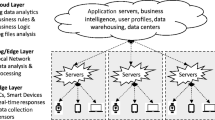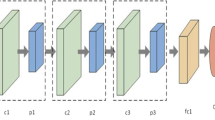Abstract
Current advancement in Internet-of-Things, Cyber-Physical Systems, Cloud-of-Things, and Edge-of-Things technologies have enabled us to design more advanced and event-sensitive real-time monitoring solutions. IoT-assisted healthcare systems need local data processing environment for effective decision making. In the proposed study, a novel edge analytics-assisted monitoring solution is proposed to monitor several physical activities of the patient to determine physical inactivity from their daily routine. Wearable sensors are utilized to monitor physical movements. The main objective of the proposed study is to calculate the scale of the physical inactivity of the patient to make real-time health suggestions. Graphical Processing Unit (GPU) enabled edge nodes are utilized for efficient data processing. An application scenario is proposed to validate the ideology of the proposed system in the healthcare environment. The performance is compared with both machine learning and deep learning-based approaches to justify the proposed system. iFogSim simulator is utilized to simulate the proposed scenario and the performance is validated based on the computation of movement recognition efficiency, network bandwidth efficiency, interoperability, Edge-based data processing reliability and alert generation-based patient security.













Similar content being viewed by others
References
Jefferis BJ, Lennon L, Whincup PH, Wannamethee SG (2012) Longitudinal associations between changes in physical activity and onset of type 2 diabetes in older British men: the influence of adiposity. Diabetes Care. https://doi.org/10.2337/dc11-2280
Arif M, Kattan A (2015) Physical activities monitoring using wearable acceleration sensors attached to the body. PLoS One. https://doi.org/10.1371/journal.pone.0130851
Mannini A, Intille SS, Rosenberger M et al (2013) Activity recognition using a single accelerometer placed at the wrist or ankle. Med Sci Sports Exerc. https://doi.org/10.1249/MSS.0b013e31829736d6
Shi W, Cao J, Zhang Q et al (2016) Edge Computing: vision and challenges. IEEE Internet Things J 3:637–646. https://doi.org/10.1109/JIOT.2016.2579198
Yin J, Yang Q, Pan JJ (2008) Sensor-based abnormal human-activity detection. In: IEEE transactions on knowledge and data engineering, pp 637–646
Kingma DP, Ba JL (2015) Adam: a method for stochastic optimization. arXiv Prepr
Baek J, Lee G, Park W, Yun B-J (2010) Accelerometer signal processing for user activity detection, pp 610– 617
Gjoreski M, Gjoreski H, Lustrek M, Gams M (2016) How accurately can your wrist device recognize daily activities and detect falls? Sensors (Switzerland), https://doi.org/10.3390/s16060800
Khan AM, Lee YK, Lee SY, Kim TS (2010) A triaxial accelerometer-based physical-activity recognition via augmented-signal features and a hierarchical recognizer. IEEE Trans Inf Technol Biomed, https://doi.org/10.1109/TITB.2010.2051955
Bengio Y (2006) Learning phrase representations using RNN encoder-decoder for statistical machine translation. J Biol Chem, https://doi.org/10.1074/jbc.M608066200
Sacchi L, Larizza C, Combi C, Bellazzi R (2007) Data mining with temporal abstractions: learning rules from time series. Data Min Knowl Discov, https://doi.org/10.1007/s10618-007-0077-7
Minnen D, Starner T, Ward JA et al (2005) Recognizing and discovering human actions from on-body sensor data. In: IEEE international conference on multimedia and expo. ICME, p 2005
Giansanti D, Macellari V, Maccioni G (2008) New neural network classifier of fall-risk based on the Mahalanobis distance and kinematic parameters assessed by a wearable device. Physiol Meas, https://doi.org/10.1088/0967-3334/29/3/N01
Narayanan MR, Scalzi ME, Redmond SJ et al (2009) A wearable triaxial accelerometry system for longitudinal assessment of falls risk, pp 2840–2843
Marschollek M, Wolf K-H, Gietzelt M et al (2009) Assessing elderly persons fall risk using spectral analysis on accelerometric data - a clinical evaluation study, pp 3682–3685
Atallah L, Lo B, King R, Yang GZ (2011) Sensor positioning for activity recognition using wearable accelerometers. In: IEEE transactions on biomedical circuits and systems, pp 320–329
Cleland I, Kikhia B, Nugent C et al (2013) Optimal placement of accelerometers for the detection of everyday activities. Sensors (Basel), https://doi.org/10.3390/s130709183
Bao L, Intille SS (2004) Activity recognition from user-annotated acceleration data, pp 1–17
Olguin DO, Pentland AS (2006) Human activity recognition: accuracy across common locations for wearable sensors. In: IEEE 10th international symposium on wearable computers, pp 11–14
Kern N, Schiele B, Schmidt A (2011) Multi-sensor activity context detection for wearable computing, pp 220–232
Gjoreski H, Lustrek M, Gams M (2011) Accelerometer placement for posture recognition and fall detection. In: Proceedings - 2011 7th international conference on intelligent environments, IE 2011, pp 47–54
Berndt D, Clifford J (1994) Using dynamic time warping to find patterns in time series. In: KDD-94 workshop on knowledge discovery in databases, pp 359–370
Wang L, Gu T, Tao X, Lu J (2012) A hierarchical approach to real-time activity recognition in body sensor networks. Pervasive Mob Comput 8:115–130. https://doi.org/10.1016/j.pmcj.2010.12.001
Krishnan NC, Cook DJ (2014) Activity recognition on streaming sensor data. Pervasive Mob Comput 10:138–154. https://doi.org/10.1016/j.pmcj.2012.07.003
Plotz T, Hammerla NY, Olivier P (2011) Feature learning for activity recognition in ubiquitous computing. In: IJCAI international joint conference on artificial intelligence, pp 1729–1734
Banos O, Garcia R, Holgado-Terriza JA et al (2014) mHealthDroid: a novel framework for agile development of mobile health applications, pp 91–98. https://doi.org/10.1007/978-3-319-13105-4-14
Banos O, Villalonga C, Garcia R, et al. (2015) Design, implementation and validation of a novel open framework for agile development of mobile health applications. Biomed Eng Online 14:1–20. https://doi.org/10.1186/1475-925X-14-S2-S6
Gers FA, Schraudolph NN, Schmidhuber J (2003) Learning precise timing with LSTM recurrent networks. J Mach Learn Res 3:115–143. https://doi.org/10.1162/153244303768966139
Graves A, Mohamed AR, Hinton G (2013) Speech recognition with deep recurrent neural networks. In: ICASSP, IEEE international conference on acoustics, speech and signal processing - proceedings, pp 6645–6649
Lai L, Suda N, Chandra V (2018) CMSIS-NN: efficient neural network kernels for arm cortex-M CPUs, pp 1–10
Zhu H, Chen H, Brown R (2018) A sequence-to-sequence model-based deep learning approach for recognizing activity of daily living for senior care. J Biomed Inform 84:148–158. https://doi.org/10.1016/j.jbi.2018.07.006
Hammerla NY, Halloran S, Plotz T (2016) Deep, convolutional, and recurrent models for human activity recognition using wearables. In: IJCAI international joint conference on artificial intelligence, pp 1533–1540
Chen Y, Xue Y (2016) A deep learning approach to human activity recognition based on single accelerometer. In: Proceedings - 2015 IEEE international conference on systems, man, and cybernetics, SMC 2015
Yang JB, Nguyen MN, San PP et al (2015) Deep convolutional neural networks on multichannel time series for human activity recognition. In: IJCAI international joint conference on artificial intelligence, pp 3995–4001
Goodfellow I, Bengio Y, Courville A (2016) Deep learning. MIT Press, Cambridge
Cho K, Van Merrienboer B, Gulcehre C, Bahdanau D, Bougares F, Schwenk H, Bengio Y (2006) Learning phrase representations using RNN encoder – decoder for statistical machine translation. J Biol Chem, https://doi.org/10.1074/jbc.M608066200
Karumbaya A, Satheesh G (2015) IoT empowered real time environment monitoring system. Int J Comput Appl, https://doi.org/10.5120/ijca2015906917
Werbos PJ (1990) Backpropagation through time: what it does and how to do it. Proc IEEE, https://doi.org/10.1109/5.58337
Ahmed E, Ahmed A, Yaqoob I, et al. (2017) Bringing computation closer toward the user network: is edge computing the solution? IEEE Commun Mag 55:138–144. https://doi.org/10.1109/MCOM.2017.1700120
Lee T (2017) Elastic motif segmentation and alignment of time series for encoding and classification. Time Ser Work NIPS 2017:1–8
Judice PB, Santos DA, Hamilton MT et al (2015) Validity of GT3X and Actiheart to estimate sedentary time and breaks using ActivPAL as the reference in free-living conditions. Gait Posture 41:917–922. https://doi.org/10.1016/j.gaitpost.2015.03.326
Abadi M, Agarwal A, Barham P et al (2016) TensorFlow: large-scale machine learning on heterogeneous distributed systems
Zaremba W, Sutskever I, Vinyals O (2014) Recurrent neural network regularization, pp 1–8
Deboeverie F, Roegiers S, Allebosch G et al (2017) Human gesture classification by brute-force machine learning for exergaming in physiotherapy. In: IEEE conference on computational intelligence and games, CIG, pp 1–7
Kiranyaz S, Ince T, Gabbouj M (2016) Real-time patient-specific ECG classification by 1-D convolutional neural networks. IEEE Trans Biomed Eng 63:664–675. https://doi.org/10.1109/TBME.2015.2468589
Gupta H, Vahid Dastjerdi A, Ghosh SK, Buyya R (2017) iFogSim: a toolkit for modeling and simulation of resource management techniques in the Internet of Things, Edge and Fog computing environments. In: Software - practice and experience, pp 1275–1296
Author information
Authors and Affiliations
Corresponding author
Additional information
Publisher’s Note
Springer Nature remains neutral with regard to jurisdictional claims in published maps and institutional affiliations.
Rights and permissions
About this article
Cite this article
Manocha, A., Singh, R. A Novel Edge Analytics Assisted Motor Movement Recognition Framework Using Multi-Stage Convo-GRU Model. Mobile Netw Appl 27, 657–676 (2022). https://doi.org/10.1007/s11036-019-01321-8
Published:
Issue Date:
DOI: https://doi.org/10.1007/s11036-019-01321-8




